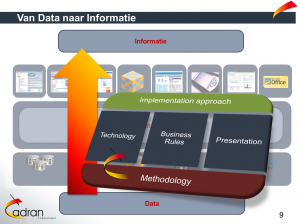
BI – The answer to the question about life, the universe and everything is 42
Oracle BI – Thoughts (1) – Cadran publishes a series of articles about the ideas surrounding Oracle Business Intelligence in combination with Oracle JD Edwards. In these articles various considerations and reflections are discussed, which can be helpful in making the right decisions in the implementation and application of both systems. This first article discusses definitions and provides a conceptual platform.
In the comic science fiction book “The Ultimate Hitchhiker’s Guide to the Galaxy” by Douglas Adams, a supercomputer is built at some point to which the ultimate question can be asked: The question about life, the universe and everything. After years of calculating, the supercomputer comes up with the answer: 42. Because people realize that they do not care much about that, they are now building a computer that can ask the right question.
Information needs exist within each company. Regardless of chosen systems, which are ‘only’ tools, a company needs insight into ins and outs. This can be as simple as noticing that the bank balance is positive and that more money is coming in than there is going out, but usually decision-makers, tax authorities and accountants want more information. Account must be taken. In addition, company information provides tools to steer at operational, tactical and strategic level. There is therefore an information need in all layers of the organization that varies in detail.
From data to information
On the one hand, a business administration ensures the recording of all relevant source data. For the sake of convenience, let’s assume that Oracle JD Edwards is the ERP system, to which the back office administration is entrusted. In addition, many other sources will contain information from and about the organization, such as HR systems for personnel and payroll administration, production systems for the manufacturing process, and laboratory systems for testing and qualifying raw materials and / or end products. Next, every organization will have an immeasurable amount of knowledge stored in countless documents, notes, e-mails, rules and (not least) the people’s heads.
All this adds up to an ocean of data from which it can be tapped. By throwing the right rods at the right time at the right place, it is possible to hand over the right information from the data to the right people at the right time. After all, data are only static facts. Data is transferred to information as soon as value can be derived from this.
Measuring is knowing
In order to lead an organization in the right direction, statutes, business plans, business rules, work instructions and job and job descriptions, but also legislation ensure that everyone does what they have to do and that the processes in the organization are carried out in an efficient and correct manner. In order to gain insight into this and to be able to send it, information is needed. A lot of information. Information needs in every level of the organization. In addition, an organization must account for externally at all levels. Think of government and financiers, such as banks, shareholders, investors, but of course also to customers and suppliers. Legislation further increases this by imposing requirements with regard to annual reporting and tax returns. With increasing demands on the environment and traceability, the need to register the smallest details explodes even further. Finally, consumers demand more and more insight into the smallest details of products and their origin. Data is needed to provide this information throughout the entire chain. A lot of data.
Scale is everything
Compare the tricycle in the backyard of a four-year-old with a jumbo jet piloted by six people with more than 500 passengers on board. Both serve a transport need, but on a slightly different scale with slightly different requirements. A farm with three chickens and two apple trees is probably able to have insight in the performance of the company without administration. The farmer will know by heart how the eggs and apples are produced on an annual basis and what the selling price of both should be. If the size of the company increases, this will quickly become difficult, especially when several people are involved, who fulfill different functions and roles. A company that operates at a global level and trades thousands of products and employs thousands of people, enforces the help of systems to have an overall picture in mind. Scale and size always result in the passing of tilt points that dictate the size, weight and size of such systems.
Definition, definition and again definition
- a unit (eg 42%);
- a fact (eg 42% margin);
- a dimension (eg from the main product group in September this year);
- a comparison (eg 10% more than September last year);
- a standard (eg 5% below the target);
With each sentence the number 42 gets more value, more meaning, more information and more control possibilities. With each sentence, the number also raises more and more questions, the answers of which must be known to sail blindly on this number:
- Per cent?
- Compared to what?
- Which formula is behind this?
- Which components are included in that formula?
- How did those components come about?
- Margin?
- What is margin?
- Which Revenue and what costs determine this margin?
- Product group? September?
- What is actually the most important product group?
- Who determines that?
- What is September this year? Is that fiscal period or calendar month?
- Which date is the basis for this? Is that invoice date or shipping date?
…
And so you can continue for a while. Annoying, difficult, and meticulous questions. However, no one will be able to use, interpret and trust the number 42 without having to implicitly or explicitly answer all these questions. The fact must be provided with semantics and rules.
CogNIAM
Science deals with such issues and provides models and methods to catch facts in rules and to provide this semantics. With CogNIAM, the knowledge and information can be transferred more quickly to the application and use of knowledge and problem solving. With the help of CogNIAM it is also possible to apply knowledge more effectively, to improve accuracy and care and to communicate better. The method used is clear and consists of skills and regulations that can be learned and used by everyone. Thanks to the universal approach, CogNIAM can be applied to all disciplines where knowledge and information are involved. CogNIAM is also called an information analysis method, a knowledge structuring method, a learning accelerator and a communication enhancer. Knowledge Based Working and CogNIAM are based on the emerging standards for modeling data and processes and making use of, among others, Unified Modeling Language (UML), Business Process Management (BPMN) and SBVR (Semantics of Business Vocabulary & Business Rules).
The similarities between this method and the three-layeredness of the Oracle BI information model are striking. In Oracle BI, the three layers Physical Layer, Logical Layer and Presentation Layer are distinguished.
The pyramid of CogNIAM is about an under layer with facts, a middle layer with domain-specific regulations and a semantic layer with generic regulations. In a next article we will go deeper into these layers.
Ralph Kimball
 And when science is brought in, Ralph Kimball can not be unmentioned. His theories and scientific treatises on dimensional modeling date from a long time before the time of business intelligence software solutions. However, this philosophy has been thoroughly and thoroughly implemented in Oracle Business Intelligence and all aspects of his ideas are reflected in the software and solutions. This is certainly not to say about every business intelligence solution. It is recommended to take note of his work. Chapter 6 of his book Datawarehouse Life Cycle Tool Kit is a good start and describes the fundamentals of this dimensional modeling. Tough reading, but essential for a good understanding of the matter.
And when science is brought in, Ralph Kimball can not be unmentioned. His theories and scientific treatises on dimensional modeling date from a long time before the time of business intelligence software solutions. However, this philosophy has been thoroughly and thoroughly implemented in Oracle Business Intelligence and all aspects of his ideas are reflected in the software and solutions. This is certainly not to say about every business intelligence solution. It is recommended to take note of his work. Chapter 6 of his book Datawarehouse Life Cycle Tool Kit is a good start and describes the fundamentals of this dimensional modeling. Tough reading, but essential for a good understanding of the matter.
Dictionary
To apply the above treatises in practice, a company dictionary is a godsend. Business analysts are able to compile such a list of concepts and to coordinate within the organization and to find consensus about it. This is not an easy task, but an essential starting point for the added value that Oracle Business Intelligence can offer. For example, dusty, static and meaningless numbers and figures change into living, colorful and valuable insights and control possibilities. In addition, it is the basis to prevent the proliferation of stand-alone reports, endless Excel sheets, but also larger risks. With the latter you can think of:
- Great chance of misinterpretation of and therefore wrong decisions due to (incorrect) data.
- Great chance of inefficiency of labor productivity within ICT and departments that produce reports.
- Great chance that solutions offered are not used. When people do not understand the data or can not read it, they will fall back on other means or start to produce new overviews themselves.
- Great chance of disinvestments and / or too long and too expensive implementation processes of software.
- Great chance of inefficiency in the organization due to many and repeated discussions and explanation of the terms used, key figures and reports.
Analysis
To complete and cover the description of a business concept, a following checklist can be used:
- Business definition (what does the company mean by Revenue)
- Data definition (what is the content and formula of Revenue and what basic facts are the basis)
- Fact definition (what are the basic facts and how can they be defined)
- Functional definition (how to realize this fact in Oracle Business Intelligence)
- Logical definition (how is this measured value aggregated and against which dimensions should it be unlocked)
- Time definition (if this measured value has to be unlocked over time with which date that happens)
- Selection criteria (which selection criteria and filters are the basis)
- Implementation criteria (how to find this functionally / logically in the data source (JD Edwards))
- Technical definition (which fields in which tables can provide this information)
- Security (who can do something with this information)
At a higher level, the subject areas and data groups will have to be defined and described. These are initially driven by the information requirement that Oracle Business Intelligence must be able to serve. The following issues can help:
- Which current reports exist and which information needs do they provide?
- Which KPIs and measured values are used and are critical for monitoring and controlling the business processes?
- What information is currently being collected and edited in Excel?
- Which reporting areas can be recognized?
- Which dimensions play a role?
- Which zoom-in or drill-down needs exist?
- Which publication requirements exist for reports?
- What frequency or accuracy of underlying data is necessary?
- Which users, roles and authorization structure applies?
My next articles will go deeper into essential elements such as dimensional modeling and the facts, dimensions and star schemes that play a role here.
The implementation of a BI solution is more than the implementation of a software solution. Cadran’s vision is focused on determining the right information that is available to the right people in your organization at the right time. A thorough project approach is very important to prevent the pitfalls of such an implementation. BI is not about developing reports or creating nice dashboards. BI is about managing your organization and Cadran is your partner when it comes to Business Intelligence and JD Edwards. Do you want to know more?
Author: Rick Brobbel
BI Consultant at Cadran Consultancy




